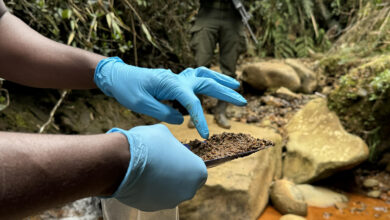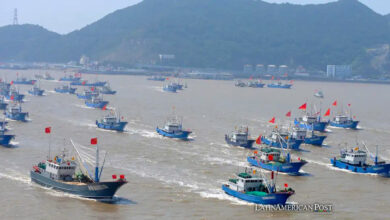Drought Devastation in Mexico Leads to Mass Fish Deaths and Rural Exodus

The severe drought in Mexico’s northern state of Chihuahua has killed millions of fish in Bustillos Lagoon, driving many farmers to abandon their lands as water resources dwindle.
In the northern state of Chihuahua, Mexico, the Bustillos Lagoon has become a grim spectacle as thousands of dead fish blanket its surface. The culprit? An intense and unrelenting drought. This environmental crisis is emblematic of a broader issue affecting nearly 90% of Mexico, marking the highest drought rate since 2011.
The small town of Anahuac in Chihuahua has borne witness to the alarming sight of mass fish deaths in the Bustillos Lagoon. These events coincide with prolonged dry spells and soaring temperatures exceeding 40 degrees Celsius (104 degrees Fahrenheit). Local officials report that the lagoon’s water levels have reached critically low points, exacerbating the situation.
This is not the first time such an event has occurred. Similar occurrences have happened in previous years when the lagoon dried up, leaving fish stranded and doomed. The frequency and severity of these incidents underscore the escalating impact of climate change and extreme weather patterns on the region.
The Broader Drought Impact
Chihuahua state is among the most brutal hit, with most of its territory engulfed by the most extreme levels of dryness. The drought’s reach extends beyond the fish in Bustillos Lagoon, affecting many residents’ livestock, agriculture, and livelihoods. Cows, donkeys, and other livestock are perishing as dams run low, and farmers face insurmountable challenges in securing water for their crops and animals.
The heat and drought have become so severe that numerous people who rely on agriculture are forced to leave their homes for better living conditions. This rural exodus highlights the socioeconomic impacts of environmental degradation, as communities that traditionally depended on farming and livestock are now grappling with existential threats to their way of life.
Droughts have historically plagued Latin America, with varying degrees of severity across different regions. Drought cycles have long been documented in Mexico, affecting agriculture and water resources. The current situation in Chihuahua is part of a larger pattern that has seen periods of extreme dryness, often linked to broader climatic phenomena like El Niño.
The interplay between natural climate variability and human-induced climate change has exacerbated the frequency and intensity of droughts. This has profound implications for water management, agricultural productivity, and rural livelihoods. Historically, Latin American countries have had to navigate the delicate balance of using their water resources sustainably while supporting agricultural growth and urban development.
Environmental and Economic Implications
The environmental implications of the current drought in Chihuahua are vast. Aquatic ecosystems, like that of Bustillos Lagoon, are particularly vulnerable. The mass death of fish disrupts the local food chain and affects water quality and the broader ecological balance. These disruptions can have cascading effects on other wildlife and plant species dependent on the lagoon’s ecosystem.
Economically, the drought is devastating for local farmers and ranchers. Agriculture is a cornerstone of the regional economy, and water scarcity directly impacts crop yields and livestock health. The financial strain on farmers, many of whom operate on thin margins, is immense. As water sources dry up, the cost of maintaining crops and livestock rises, leading to potential economic collapse for those unable to adapt or relocate.
The Human Toll and Rural Exodus
The human toll of the drought extends beyond the immediate physical and economic impacts. As people are forced to abandon their homes and lands, the cultural and social fabric of rural communities is under threat. This rural exodus is a search for water and a quest for survival. Families who have farmed the same land for generations find themselves at a crossroads, contemplating an uncertain future in unfamiliar urban environments.
The loss of rural populations can lead to declining local cultures and traditions. Agricultural knowledge, passed down through generations, risks being lost as younger generations move away from farming. This migration also strains urban areas, which must absorb the influx of rural migrants seeking employment and resources.
The Mexican government has acknowledged the severity of the drought and its widespread impacts. Efforts to mitigate the effects include emergency water distributions, financial aid to affected farmers, and investments in water infrastructure to improve storage and distribution. However, these measures are often reactive rather than proactive, addressing immediate needs without comprehensively tackling the root causes of water scarcity.
Long-term solutions require a comprehensive approach to water management, climate resilience, and sustainable agricultural practices. This includes the development of drought-resistant crops, improved irrigation techniques, and restoring natural water systems. Enhancing the capacity of local communities to manage their water resources sustainably is crucial for building resilience against future droughts.
The Role of Climate Change
Climate change plays a significant role in Latin America’s increasing frequency and severity of droughts. Rising global temperatures lead to changes in precipitation patterns, more intense heat waves, and altered hydrological cycles. These changes exacerbate water scarcity, making it more challenging for regions like Chihuahua to maintain their water supplies.
Addressing climate change at both the local and global levels is essential for mitigating drought impacts. This involves reducing greenhouse gas emissions, investing in renewable energy, and adopting sustainable land and water use practices. International cooperation and funding are also critical to supporting countries like Mexico in climate adaptation and mitigation efforts.
Community and International Support
Local communities are often the first to respond to drought conditions, employing traditional knowledge and practices to cope with water scarcity. Community-based water management initiatives can effectively ensure equitable distribution and conservation of water resources. Empowering local communities through education and capacity-building is essential for long-term resilience.
International organizations and NGOs also play a vital role in supporting drought-affected regions. By providing technical assistance, funding, and advocacy, these organizations help to implement sustainable solutions and raise awareness about the broader implications of climate change.
The mass fish deaths in Bustillos Lagoon are a stark reminder of the devastating impacts of drought in Mexico’s northern Chihuahua. This crisis is a microcosm of Latin America’s broader environmental, economic, and social challenges as climate change exacerbates water scarcity.
Addressing these challenges requires a multi-faceted approach that includes immediate relief efforts, long-term sustainable water management, and robust climate action. By leveraging traditional knowledge, technological innovations, and international cooperation, it is possible to build resilience against future droughts and protect the livelihoods of those most affected.
Also read: The Death of 157 Howler Monkeys in Mexico Sparks Urgent Conservation Efforts
As the world grapples with the realities of climate change, the situation in Chihuahua underscores the urgent need for comprehensive strategies to ensure water security and support vulnerable communities. Only through concerted and sustained efforts can we mitigate the impacts of drought and safeguard the future of regions like Chihuahua.





